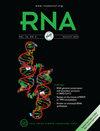新颖的前 RNA 检测工作流程 "Riboprobing "可简单识别未描述的 RNA 物种。
IF 4.2
3区 生物学
Q2 BIOCHEMISTRY & MOLECULAR BIOLOGY
引用次数: 0
摘要
核糖体可将 mRNA 翻译成蛋白质,是每种生物体所必需的。在真核生物中,核糖体的两个亚基都是按照严格的等级顺序快速组装的,从核仁开始,转录一个共同的前体核糖体 RNA(pre-rRNA)。前 rRNA 编码四个成熟 rRNA 中的三个,而成熟 rRNA 是通过几个连续的核内和核外加工步骤形成的。一直以来,Northern 印迹用于分析各种不同的前 rRNA 种类,只能粗略估计其长度。虽然可以通过引物延伸(Primer Extension)克服这一局限性,但这两种方法通常都使用放射性,耗时且成本高昂。在这里,我们提出了 "Riboprobing",这是一种基于反转录的工作流程,通过连接子连接进行扩展,可方便快捷地检测和鉴定各种pre-rRNA种类及其5'和3'末端。利用标准分子生物学实验室设备,我们的技术可以可靠地分辨出 Northern 印迹法无法分辨的 pre-RNA 种类(如:27SA2、27SA3 和 27SB)。该方法可成功用于分析细胞总提取物和纯化的前核糖体,以直接评估突变基因版本或抑制剂的影响。在该方法的开发过程中,我们发现并鉴定了一种迄今为止尚未描述过的、因氯化锂抑制作用而产生的畸变 pre-RNA。这种pre-rRNA片段横跨加工位点A1到E,形成了一个小的RNP,缺乏大多数早期连接组装因子。这一发现拓展了我们对细胞如何处理严重pre-rRNA加工缺陷的认识,并证明了组装过程对5'ETS的严格要求。本文章由计算机程序翻译,如有差异,请以英文原文为准。
The novel pre-rRNA detection workflow “Riboprobing” allows simple identification of undescribed RNA species.
Ribosomes translate mRNA into proteins and are essential for every living organism. In eukaryotes both ribosomal subunits are rapidly assembled in a strict hierarchical order, starting in the nucleolus with transcription of a common precursor ribosomal RNA (pre-rRNA). This pre-rRNA encodes three of the four mature rRNAs which are formed by several, consecutive endonucleolytic and exonucleolytic processing steps. Historically, Northern Blots are used to analyze the variety of different pre-rRNA species, only allowing rough length estimations. Although this limitation can be overcome with Primer Extension, both approaches often use radioactivity and are time consuming and costly. Here we present “Riboprobing” a reverse transcription-based workflow extended by linker ligation for easy and fast detection and characterization of various pre-rRNA species and their 5` as well as 3` ends. Using standard molecular biology lab equipment, our technique allows reliable discrimination of pre-rRNA species not resolved by Northern Blotting (e.g.: 27SA2, 27SA3 and 27SB). The method can be successfully used for analysis of total cell extracts as well as purified pre-ribosomes for a straightforward evaluation of the impact of mutant gene versions or inhibitors. In the course of method development, we identified and characterized a hitherto undescribed aberrant pre-rRNA, arising from LiCl inhibition. This pre-rRNA fragment spans from processing site A1 to E, forming a small RNP that is lacking most early joining assembly factors. This finding expands our knowledge of how the cell deals with severe pre-rRNA processing defects and demonstrates the strict requirement for the 5’ETS for the assembly process.
求助全文
通过发布文献求助,成功后即可免费获取论文全文。
去求助
来源期刊

RNA
生物-生化与分子生物学
CiteScore
8.30
自引率
2.20%
发文量
101
审稿时长
2.6 months
期刊介绍:
RNA is a monthly journal which provides rapid publication of significant original research in all areas of RNA structure and function in eukaryotic, prokaryotic, and viral systems. It covers a broad range of subjects in RNA research, including: structural analysis by biochemical or biophysical means; mRNA structure, function and biogenesis; alternative processing: cis-acting elements and trans-acting factors; ribosome structure and function; translational control; RNA catalysis; tRNA structure, function, biogenesis and identity; RNA editing; rRNA structure, function and biogenesis; RNA transport and localization; regulatory RNAs; large and small RNP structure, function and biogenesis; viral RNA metabolism; RNA stability and turnover; in vitro evolution; and RNA chemistry.
 求助内容:
求助内容: 应助结果提醒方式:
应助结果提醒方式:


